Photoshop CC’s New Smart Sharpen
Photoshop CC offers new improved with reduced haloing and noise.
View more Photoshop Videos here.
Learn more in my digital photography and digital printing workshops.
Photoshop CC offers new improved with reduced haloing and noise.
View more Photoshop Videos here.
Learn more in my digital photography and digital printing workshops.
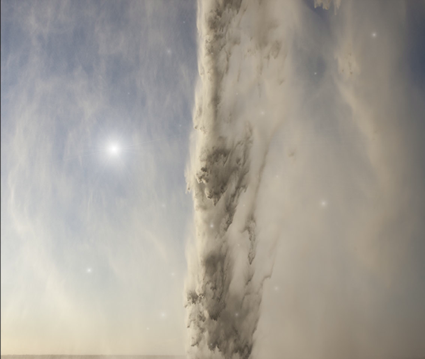
Enjoy two inspiring exhibits by internationally acclaimed artist John Paul Caponigro – Around The World & Process.
Around the world unveils new highlights from his recent international travels north of the Arctic Circle and south of the Antarctic Circle with stops along the way in Iceland, Argentina, Bolivia, and Namibia Amid images of glowing auroras, crashing glaciers, colliding icebergs, thundering waterfalls, smoldering volcanoes, shimmering salt flats, shifting dunes, you’ll find the oldest desert, the largest salt flat, the windiest continent, the fastest moving glaciers, and more, all portrayed through the eyes of this unique artist.
Process displays many aspects of the artist’s creative process, both analog and digital – writing, drawing, painting, photography. John Paul shows how each discipline contributes to the completion of his finished works of art. This exhibit shows how artist’s get there is just as important as where they arrive and reveals that the creative process is a never-ending journey of discovery that offers many insights along the way.
The book Process is now available in print and electronically. It shows many more works than can be displayed and shares the personal insights of the artist. Preview it online at johnpaulcaponigro.com/store.
John Paul Caponigro’s Annual Exhibition 2013: Around The World and Process is a rare opportunity to view this artist’s work presented in his own private studio / gallery. The exhibit is open to the public for one weekend only – August 3rd and 4th from 10 am to 5 pm with a talk by the artist at 2 pm.
Come enjoy prints, drawings, paintings, books, and conversations with the artist during this very special event.
Preview select new works online here.
For more information including directions, previews, reviews, statements, audio, video, and press kit visitwww.johnpaulcaponigro.com or email info@johnpaulcaponigro.com.
Get directions here.
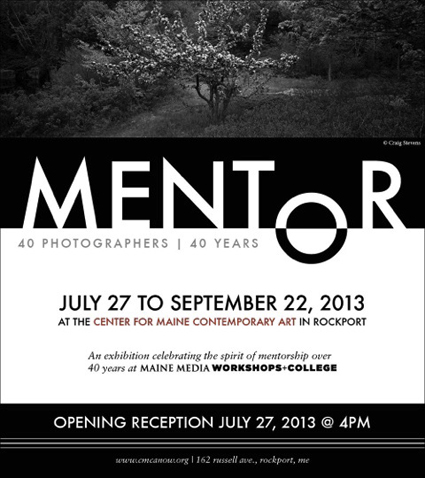
Artists learn and hone their craft in many ways, but perhaps no relationship is more instructive and lasting than one built with a mentor. Sharing a lifetime of knowledge with another artist—from favorite techniques and tools of the craft to inspiring self-criticism and deeper motivation—mentors can propel an artist forward, illuminate new creative territory and serve as a guide through periods of self-doubt.
For 40 years, Maine Media has fostered relationships between emerging and established artists through its intense and immersive courses, building bonds between teachers and students that have lasted decades and spanned the globe. Maintaining their relationships long after the lessons have ended, many of our students have gone on to become masters in their own right, and now pass on their knowledge to a new generation of emerging artists.
As part of the yearlong celebration marking our 40th anniversary, we are thrilled to announce the upcoming exhibition,Mentor: 40 Photographers, 40 Years, in partnership with the Center for Maine Contemporary Art. The exhibition will feature the work of some of Maine Media’s best-known master teachers alongside the work of their students, who continue the connection with Maine Media through teaching and mentoring.
Curated by Bruce Brown and Brenton Hamilton, Mentor will be on display from July 27 to September 22, 2013 at the Center for Maine Contemporary Art here in Rockport. We hope you will join us at the opening reception on July 27, or at the alumni reception on August 10 to celebrate the spirit of creative collaboration that is at the heart of everything we do here at Maine Media.
Find out more about the Mentor Exhibit here.
Learn about my Annual Exhibit here.
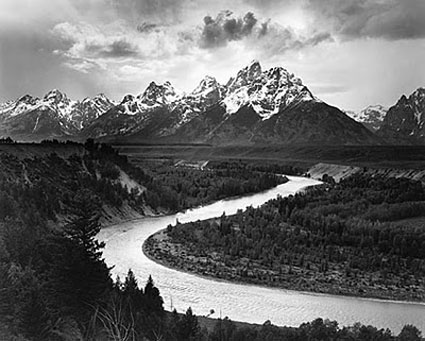
I highly recommend you look at original masterworks – frequently.
While looking at works in reproduction often provide many wonderful insights, nothing but the original provides the full experience. Looking at masterworks helps you understand what’s possible, demonstrates how materials enhance expression, and provides a fuller, clearer, deeper window into the intentions of artists’ works.
Without looking at original, you might understand that Ansel Adams had unparalleled technical mastery of black-and-white silver gelatin printing, but would you also understand that he was a transcendentalist of light and that his use of light was quite different than Edward Steichen’s?
Without looking at originals, you might understand that Richard Avedon’s work was clearly seen and sharply focused, but would you also understand that the detail in his portraits become a statement about human relationships / human nature and that his use of detail is quite different than William Henry Jackson’s?
Without looking at originals, you might understand that size is often connected with price in Andreas Gursky’s work, but would you also understand how important it is for you to experience the field of view filling spaces in his work as immersive and that his use of scale is quite different than Andy Warhol’s?
If you don’t look at original works of art, you may miss a lot.
Keith Carter thinks of his graduate studies as being comprised of long sessions looking at original master works. As a young man, he saved enough money to make the trip to New York City and spend days in the collections of the finest museums in the world looking at some of the finest photographs in the history of the medium. He called ahead to make an appointment with each of the museums to see specific prints in their private viewing rooms. (Many people don’t know they can do that.)
Looking at original masterworks is both inspiring and enlightening. I’ve been very fortunate to be able to look at masterworks in my home all my life and I seek out opportunities to see more whenever possible. I recommend you do too.
(There’s a lot to be learned from looking at originals, which is why we look at masterworks from my collection in all of my digital printing workshops.)
Find my comments on other Masterworks In My Collection here.
Learn more in my digital printing workshops.
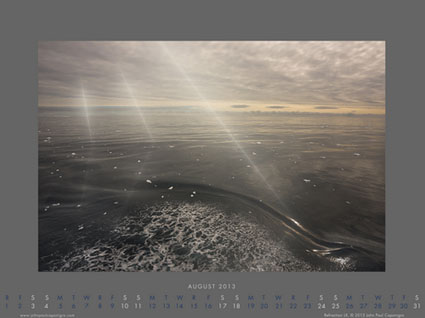
My free August desktop calendar features an image from Antarctica.
Download it here now.
Find out about upcoming events here.

While this image is officially titled Apple, New York City, 1964, it’s often referred to in my father’s studio as ‘The Galaxy Apple’. Countless people’s first impression of this image is that they’re looking at a galaxy. Even after you see the apple, the impression of a galaxy persists.
This is one of the photographs that got me fascinated by photography. I love that a literal transcription can also describe something more than itself. The power of metaphor is more powerfully expressed in this photograph than in any other I can think of. What’s more, the way the metaphor unites both the terrestrial and the celestial – the macrocosm and the microcosm are seen as one. (I don’t think it’s an accident that my father’s first retrospective was titled The Wise Silence, a line borrowed from Ralph Waldo Emerson.)
The printing of this image reinforces the metaphor. It’s dark. It is so dark, in fact, that in some places, you can’t visually separate the contour of the apple from the dark background. Dad found the solution while printing the image; one of the proofs came out darker than anticipated. Other printers might have held all the details there were to hold in this negative. Unexpectedly and wisely, Dad didn’t. I have always appreciated my father’s consummate ability to transcend his technique and follow the call of his intuition. Rather than offering expected results, he consistently delivers unexpected solutions, not for the sake of novelty or surprise, but because he was called to serve a more powerful inner poetry.
(There’s a lot to be learned from looking at originals, which is why we look at masterworks from my collection in all of my digital printing workshops.)
Find my comments on other Masterworks In My Collection here.
Learn more in my digital printing workshops.
In this episode of Adobe Creative Cloud TV, Terry White shows how to use Camera RAW as a Filter for a non-destructive editing workflow.
View more Photoshop Videos here.
Learn more in my digital photography and digital printing workshops.
Ansel Adams’ Clearing Winter Storm, 1944 is a particularly interesting photograph to me because of its complexity. It’s a specific kind of complexity. Like many other complex images, it’s made of a lot of separate elements but is still unified. Unlike many other complex images, it can be broken into many separate images, each complete compositions in themselves; four peaks in clouds, one vertical monolith in clouds, shadowed valley between monolith and peak, waterfall and peak, waterfall and two trees, etc. (Try finding as many separate compositions in this single image like this as you can.)
When you look at prints of Ansel Adams’ Clearing Winter Storm many assumptions about the medium, the man, and his work are confirmed and challenged. It’s neutral, perhaps even slightly cold in tone, which is appropriate for the subject. The tonal scale is high contrast and full scale, perhaps heavier than expected with very full highlights and it may be surprising that some shadow detail is not preserved. The large format original renders detail well, though there are traces of visible grain in light smooth areas. There’s detail throughout the image (deep depth of field, sharp focus, full scale printing); when it was printed this may have been the sharpest image quality possible while today it looks classically smooth in comparison to new high resolution digitally sharpened images. At 16×20” it’s a medium scale enlargement, not a contact, and could have been printed larger; that it wasn’t is an interesting reflection on both the man and his times. Print quality becomes not only a window into the past of the subject but also into the medium, which this man above all others epitomized for his time.
(There’s a lot to be learned from looking at originals, which is why we look at masterworks from my collection in all of my digital printing workshops.)
Find my comments on other Masterworks In My Collection here.
Learn more in my digital printing workshops.
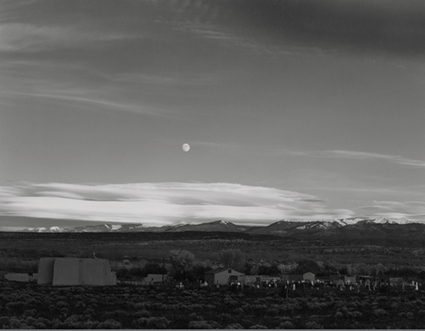
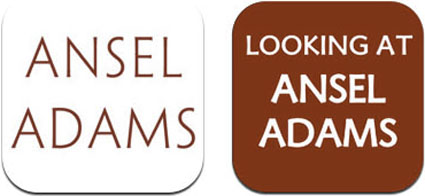
These two apps give unique windows into the life and work of photographer Ansel Adams.
The app Ansel Adams includes correspondence and a rare piano performance (Adams was trained as a classical concert pianist.)
Find it here.
My favorite thing about the app Looking At Ansel Adams is the Print Explorer where dissolves show the evolution four prints over several decades.
Find it here.
Read 22 quotes by Ansel Adams here.
Watch video on Ansel Adams here.

